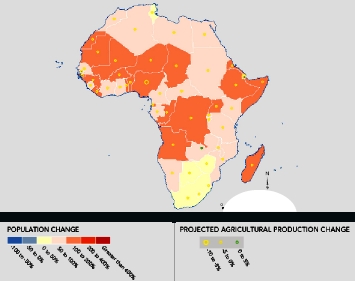- MSM on Amman meeting; eat Luigi’s dust.
- Black sigatoka disease confirmed on St Lucia; eats banana plantations.
- “Eggs come from sheep” kids survey surprise shock; eat anything.
- Qatar builds a genebank.
- On World Wetlands Day, Lake Chad protected and British farmland flooded. Will some crop wild relatives benefit?
Online map of interaction between climate change and population
Population Action has an interactive map which mashes up climate change (including its effect on total national agricultural production) with population dynamics. Here, for example, is the result for Africa. 1
The source of the agricultural production data is a 2004 crop modeling study by the Godard Institute for Space Studies distributed by CIESIN. 2 Worth taking the guided tour to start off.
You can’t imagine how many different versions of this sort of map have been on show here in Amman at the conference on food security in the drylands. Somebody ought to do an inventory…
Some answers from Amman
Ok, here goes with those answers I promised last night, or some of them anyway.
What’s so new about climate change? After all, breeders have been preparing for, and reacting to, environmental changes of various kinds since their beginning as a profession. Well, for one thing the speed of the changes, and the fact that this time there is fairly solid scientific information about long-term trends. One of the things Cal Qualset recommended is that there should be a sort of worldwide network of testing sites relevant to the anticipated environments of the most threatened countries.
He also talked about evolutionary-participatory plant breeding, a newish name for an old idea going back to Harlan and Allard. This topic was taken up by Salvatore Ceccarelli of ICARDA and others later in the day. Salvatore asked why, in this year of biodiversity, we are talking about varietal uniformity as if it were the only option. He’s set out an alternative vision here with us before.
It revolves around making large mixed populations available to farmers, getting them to plant them in lots of contrasting places, and letting natural and artificial selection do the rest. He’s been doing that in Iran and other places with a mixture of 1600 F2 barley lines deriving from some 300 parents. He thinks he can get improvements in yield stability and stress tolerance over time, but almost certainly not quality. He calls this a way to get a “local solution to a global problem.” The question that was asked, however, was how long this would take. Cal Qualset let slip almost as an aside that his group is seeing very little change in Turkish wheat landraces since the 1930s, and that the variation within landraces wasn’t as much as they had expected. He’s working on a project to introgress smut resistance into these landraces.
And speaking of farmer participation in evaluation and breeding, Cal Qualset also mentioned in his keynote that he was able to see 2% yield improvement per year in the maize Chalqueno landrace by designing and helping farmers implement, in their own fields, a mass selection scheme.
More later.
Some questions from day 2 in Amman
Got to go out to dinner, so not much time to blog, but I thought I’d tease you with some of the more interesting questions that were posed by speakers during this second day of the Amman conference on food security in the drylands under climate change. I’ll post (some of) the answers later.
Calvin Qualset: What’s so new about climate change for breeders?
Jose Cubero: Why are there no commercial faba bean hybrids?
Raj Paroda: Is aerobic rice the answer to decreasing methane emissions?
Theib Oweis: Shouldn’t we measure productivity on the basis of unit of water consumed rather than of land used?
Ken Street: Can’t we think of a better way of identifying germplasm for evaluation than core collections?
Salvatore Ceccarelli: Why, in this year of biodiversity, are we still wedded to the idea of varietal uniformity?
Day 1 at the Amman drylands conference draws to a close
The afternoon plenary (see here for the morning) consisted of talks by Drs Adel El Beltagy (GFAR) and Mark Rosegrant (IFPRI). Again, here’s what struck me particularly out of the many interesting things they said.
